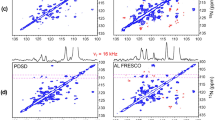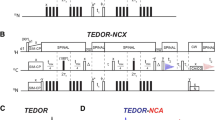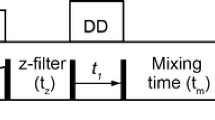Abstract
Fast magic angle spinning (MAS) NMR spectroscopy is emerging as an essential analytical and structural biology technique. Large resolution and sensitivity enhancements observed under fast MAS conditions enable structural and dynamics analysis of challenging systems, such as large macromolecular assemblies and isotopically dilute samples, using only a fraction of material required for conventional experiments. Homonuclear dipolar-based correlation spectroscopy constitutes a centerpiece in the MAS NMR methodological toolbox, and is used essentially in every biological and organic system for deriving resonance assignments and distance restraints information necessary for structural analysis. Under fast MAS conditions (rotation frequencies above 35–40 kHz), dipolar-based techniques that yield multi-bond correlations and non-trivial distance information are ineffective and suffer from low polarization transfer efficiency. To overcome this limitation, we have developed a family of experiments, CORD–RFDR. These experiments exploit the advantages of both zero-quantum RFDR and spin-diffusion based CORD methods, and exhibit highly efficient and broadband dipolar recoupling across the entire spectrum, for both short-range and long-range correlations. We have verified the performance of the CORD–RFDR sequences experimentally on a U-13C,15N-MLF tripeptide and by numerical simulations. We demonstrate applications of 2D CORD–RFDR correlation spectroscopy in dynein light chain LC8 and HIV-1 CA tubular assemblies. In the CORD–RFDR spectra of LC8 acquired at the MAS frequency of 40 kHz, many new intra- and inter-residue correlations are detected, which were not observed with conventional dipolar recoupling sequences. At a moderate MAS frequency of 14 kHz, the CORD–RFDR experiment exhibits excellent performance as well, as demonstrated in the HIV-1 CA tubular assemblies. Taken together, the results indicate that CORD–RFDR experiment is beneficial in a broad range of conditions, including both high and moderate MAS frequencies and magnetic fields.







Similar content being viewed by others
References
Bak M, Rasmussen JT, Nielsen NC (2000) SIMPSON: a general simulation program for solid-state NMR spectroscopy. J Magn Reson 147(2):296–330
Bayro MJ, Huber M, Ramachandran R, Davenport TC, Meier BH, Ernst M, Griffin RG (2009) Dipolar truncation in magic-angle spinning NMR recoupling experiments. J Chem Phys 130:114506
Bennett AE, Ok JH, Griffin RG, Vega S (1992) Chemical shift correlation spectroscopy in rotating solids: radio frequency-driven dipolar recoupling and longitudinal exchange. J Chem Phys 96(11):8624–8627
Brinkmann A, Gunne JSAD, Levitt MH (2002) Homonuclear zero-quantum recoupling in fast magic-angle spinning nuclear magnetic resonance. J Magn Reson 156(1):79–96
Delaglio F, Grzesiek S, Vuister GW, Zhu G, Pfeifer J, Bax A (1995) NMRPipe: a multidimensional spectral processing system based on Unix Pipes. J Biomol NMR 6(3):277–293
Dumez JN, Emsley L (2011) A master-equation approach to the description of proton-driven spin diffusion from crystal geometry using simulated zero-quantum lineshapes. Phys Chem Chem Phys 13(16):7363–7370
Ernst M, Meier MA, Tuherm T, Samoson A, Meier BH (2004) Low-power high-resolution solid-state NMR of peptides and proteins. J Am Chem Soc 126(15):4764–4765
Grommek A, Meier BH, Ernst M (2006) Distance information from proton-driven spin diffusion under MAS. Chem Phys Lett 427(4–6):404–409
Han Y, Hou GJ, Suiter CL, Ahn J, Byeon IJL, Lipton AS, Burton S, Hung I, Gor’kov PL, Gan ZH, Brey W, Rice D, Gronenborn AM, Polenova T (2013) Magic angle spinning NMR reveals sequence-dependent structural plasticity, dynamics, and the spacer peptide 1 conformation in HIV-1 capsid protein assemblies. J Am Chem Soc 135(47):17793–17803
Hou GJ, Deng F, Ye CH, Ding SW (2006) Towards uniform enhancement in solid-state cross polarization magnetic angle spinning NMR: a scheme incorporating cross polarization with rotational resonance. J Chem Phys 124:234512
Hou GJ, Yan S, Sun SJ, Han Y, Byeon IJL, Ahn J, Concel J, Samoson A, Gronenborn AM, Polenova T (2011) Spin diffusion driven by R-symmetry sequences: applications to homonuclear correlation spectroscopy in MAS NMR of biological and organic solids. J Am Chem Soc 133(11):3943–3953
Hou GJ, Yan S, Trebosc J, Amoureux JP, Polenova T (2013) Broadband homonuclear correlation spectroscopy driven by combined R2 vn sequences under fast magic angle spinning for NMR structural analysis of organic and biological solids. J Magn Reson 232:18–30
Hu BW, Lafon O, Trebosc J, Chen Q, Amoureux JP (2011) Broad-band homo-nuclear correlations assisted by H-1 irradiation for bio-molecules in very high magnetic field at fast and ultra-fast MAS frequencies. J Magn Reson 212(2):320–329
Hu BW, Trebosc J, Lafon O, Chen Q, Masuda Y, Takegoshi K, Amoureux JP (2012) Very-long-distance correlations in proteins revealed by solid-state NMR spectroscopy. ChemPhysChem 13(16):3585–3588
Ishii Y (2001) C-13–C-13 dipolar recoupling under very fast magic angle spinning in solid-state nuclear magnetic resonance: applications to distance measurements, spectral assignments, and high-throughput secondary-structure determination. J Chem Phys 114:8473–8483
Ladizhansky V (2009) Homonuclear dipolar recoupling techniques for structure determination in uniformly C-13-labeled proteins. Solid State Nucl Magn Reson 36(3):119–128
Luo W, Hong M (2006) Determination of the oligomeric number and intermolecular distances of membrane protein assemblies by anisotropic 1H-driven spin diffusion NMR spectroscopy. J Am Chem Soc 128(22):7242–7251
Marulanda D, Tasayco ML, McDermott A, Cataldi M, Arriaran V, Polenova T (2004) Magic angle spinning solid-state NMR spectroscopy for structural studies of protein interfaces. Resonance assignments of differentially enriched Escherichia coli thioredoxin reassembled by fragment complementation. J Am Chem Soc 126(50):16608–16620
McDermott A (2009) Structure and dynamics of membrane proteins by magic angle spinning solid-state NMR. Annu Rev Biophys 38:385–403
Morcombe CR, Gaponenko V, Byrd RA, Zilm KW (2004) Diluting abundant spins by isotope edited radio frequency field assisted diffusion. J Am Chem Soc 126(23):7196–7197
Renault M, Cukkemane A, Baldus M (2010) Solid-state NMR spectroscopy on complex biomolecules. Angew Chem Int Ed 49(45):8346–8357
Rienstra CM et al (2002) De novo determination of peptide structure with solid-state magic-angle spinning NMR spectroscopy. Proc Natl Acad Sci USA 99(16):10260–10265
Scholz I, Huber M, Manolikas T, Meier BH, Ernst M (2008) MIRROR recoupling and its application to spin diffusion under fast magic-angle spinning. Chem Phys Lett 460(1–3):278–283
Sun SJ, Butterworth AH, Paramasivam S, Yan S, Lightcap CM, Williams JC, Polenova T (2011) Resonance assignments and secondary structure analysis of dynein light chain 8 by magic-angle spinning NMR spectroscopy. Can J Chem 89(7):909–918
Sun SJ, Han Y, Paramasivam S, Yan S, Siglin AE, Williams JC, Byeon IJL, Ahn J, Gronenborn AM, Polenova T (2012a) Solid-state NMR spectroscopy of protein complexes. Protein NMR Techniques. Humana Press, New Jersey, pp 303–331
Sun SJ, Yan S, Guo CM, Li MY, Hoch JC, Williams JC, Polenova T (2012b) A time-saving strategy for MAS NMR spectroscopy by combining nonuniform sampling and paramagnetic relaxation assisted condensed data collection. J Phys Chem B 116(46):13585–13596
Szeverenyi NM, Sullivan MJ, Maciel GE (1982) Observation of spin exchange by two-dimensional fourier transform C-13 cross polarization magic-angle spinning. J Magn Reson 47(3):462–475
Takegoshi K, Nakamura S, Terao T (2001) C-13–H-1 dipolar-assisted rotational resonance in magic-angle spinning NMR. Chem Phys Lett 344(5–6):631–637
Tycko R (2011) Solid-state NMR studies of amyloid fibril structure. Annu Rev Phys Chem 62:279–299
Veshtort M, Griffin RG (2011) Proton-driven spin diffusion in rotating solids via reversible and irreversible quantum dynamics. J Chem Phys 135:134509
Weingarth M, Bodenhausen G, Tekely P (2009) Broadband carbon-13 correlation spectra of microcrystalline proteins in very high magnetic Fields. J Am Chem Soc 131:13937–13939
Weingarth M, Bodenhausen G, Tekely P (2010) Broadband magnetization transfer using moderate radio-frequency fields for NMR with very high static fields and spinning speeds. Chem Phys Lett 488(1–3):10–16
Williams JC, Roulhac PL, Roy AG, Vallee RB, Fitzgerald MC, Hendrickson WA (2007) Structural and thermodynamic characterization of a cytoplasmic dynein light chain-intermediate chain complex. Proc Natl Acad Sci USA 104(24):10028–10033
Yang J, Tasayco ML, Polenova T (2008) Magic angle spinning NMR experiments for structural studies of differentially enriched protein interfaces and protein assemblies. J Am Chem Soc 130(17):5798–5807
Acknowledgments
This work was supported by the National Institutes of Health (NIH Grants P50GM082251, R01GM085306, from NIGMS). We acknowledge the support of the National Science Foundation (NSF Grant CHE0959496) for the acquisition of the 850 MHz NMR spectrometer at the University of Delaware and the National Institutes of Health (NIH Grants P30GM103519 and P30GM110758) for the support of Core Instrumentation infrastructure at the University of Delaware.
Author information
Authors and Affiliations
Corresponding authors
Additional information
Xingyu Lu and Changmiao Guo have contributed equally to this work.
Electronic supplementary material
Below is the link to the electronic supplementary material.
Rights and permissions
About this article
Cite this article
Lu, X., Guo, C., Hou, G. et al. Combined zero-quantum and spin-diffusion mixing for efficient homonuclear correlation spectroscopy under fast MAS: broadband recoupling and detection of long-range correlations. J Biomol NMR 61, 7–20 (2015). https://doi.org/10.1007/s10858-014-9875-6
Received:
Accepted:
Published:
Issue Date:
DOI: https://doi.org/10.1007/s10858-014-9875-6




